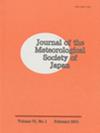改进双频降水雷达降雨率估计的贝叶斯校正方法
IF 1.6
4区 地球科学
Q3 METEOROLOGY & ATMOSPHERIC SCIENCES
引用次数: 8
摘要
全球降水测量卫星(GPM)核心观测站的双频降水雷达(Dual-frequency precipitation Radar, DPR)的一个重要目标是准确估计降水。本文提出了一种贝叶斯校正(BC)方法来改进DPR的瞬时降雨率积。以地面双极化雷达(GR)观测资料为参考,假设瞬时降雨过程为对数变换高斯分布。此外,BC算法采用了广义回归模型。考虑了降雨强度(如小雨、中雨和暴雨)及其对模型性能的可变影响。BC方法量化了与贝叶斯校正DPR (DPR_BC)降雨率估计值相关的预测不确定性。为了演示本研究中开发的概念,使用了2014年4月至2018年6月期间德克萨斯州休斯顿KHGX气象服务监视雷达(WSR-88D)的GPM立交桥数据。分析了DPR瞬时降雨率估计的观测误差与降雨强度的关系。此外,在美国东南部有强降雨记录的三个gpm立交桥案例中实现了表现最佳的BC模型。结果表明,与DPR估计相比,DPR_BC降雨率估计具有更好的技能得分,并且与GR参考更符合。该研究证明了所提出的BC算法在增强星载雷达设备瞬时降雨率产品方面的潜力。本文章由计算机程序翻译,如有差异,请以英文原文为准。
A Bayesian Correction Approach for Improving Dual-frequency Precipitation Radar Rainfall Rate Estimates
The accurate estimation of precipitation is an important objective for the Dual-frequency Precipitation Radar (DPR), which is located on board the Global Precipitation Measurement (GPM) satellite core observatory. In this study, a Bayesian correction (BC) approach is proposed to improve the DPR’s instantaneous rainfall rate product. Ground dual-polarization radar (GR) observations are used as references, and a log-transformed Gaussian distribution is assumed as the instantaneous rainfall process. Additionally, a generalized regression model is adopted in the BC algorithm. Rainfall intensities such as light, moderate, and heavy rain and their variable influences on the model’s performance are considered. The BC approach quantifies the predictive uncertainties associated with the Bayesiancorrected DPR (DPR_BC) rainfall rate estimates. To demonstrate the concepts developed in this study, data from the GPM overpasses of the Weather Service Surveillance Radar (WSR-88D), KHGX, in Houston, Texas, between April 2014 and June 2018 are used. Observation errors in the DPR instantaneous rainfall rate estimates are analyzed as a function of rainfall intensity. Moreover, the best-performing BC model is implemented in three GPM-overpass cases with heavy rainfall records across the southeastern United States. The results show that the DPR_BC rainfall rate estimates have superior skill scores and are in better agreement with the GR references than with the DPR estimates. This study demonstrates the potential of the proposed BC algorithm for enhancing the instantaneous rainfall rate product from spaceborne radar equipment.
求助全文
通过发布文献求助,成功后即可免费获取论文全文。
去求助
来源期刊
CiteScore
6.70
自引率
16.10%
发文量
56
审稿时长
3 months
期刊介绍:
JMSJ publishes Articles and Notes and Correspondence that report novel scientific discoveries or technical developments that advance understanding in meteorology and related sciences. The journal’s broad scope includes meteorological observations, modeling, data assimilation, analyses, global and regional climate research, satellite remote sensing, chemistry and transport, and dynamic meteorology including geophysical fluid dynamics. In particular, JMSJ welcomes papers related to Asian monsoons, climate and mesoscale models, and numerical weather forecasts. Insightful and well-structured original Review Articles that describe the advances and challenges in meteorology and related sciences are also welcome.

 求助内容:
求助内容: 应助结果提醒方式:
应助结果提醒方式:


